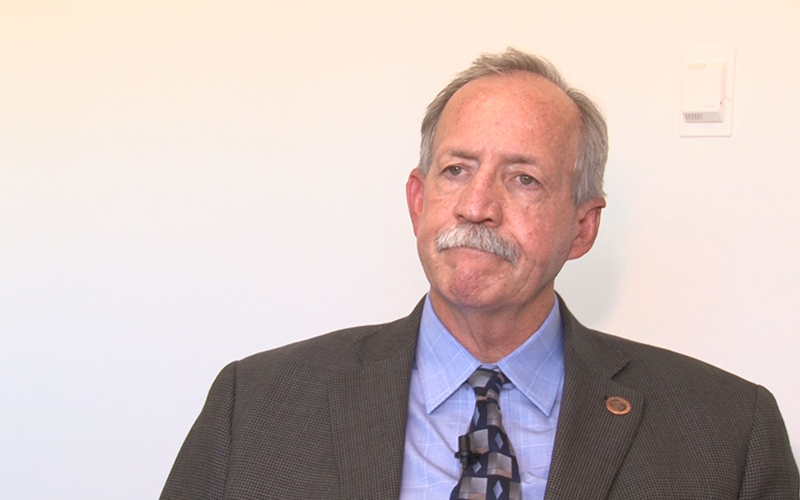
As temperatures rise and humidity drops in the summer, wildfires spread through Arizona. (Photo by Devon Christopher Adams via Creative Commons)

About 850 wildfires have spread across Arizona’s landscape this year, covering more than 205 square miles, according to Jeff Whitney, director of the Arizona State Forestry Division. (Photo by Devin Conley/Cronkite News)
PHOENIX – Soaring temperatures and dry conditions are increasing the danger of wildfires in Arizona. About 850 wildfires ripped through more than 200 square miles in Arizona this year, according to Jeff Whitney, director of the Arizona State Forestry Division.
None of the wildfires have been as catastrophic as the Yarnell Hill Fire in 2013 in which 19 firefighters died or the Rodeo Fire in 2002. But it has taken firefighter and other government resources. This week two small subdivisions near Payson were evacuated as a wildfire burned less than two miles away.
Whitney, in an interview with Cronkite News, talked about proposed budget cuts to the U.S. Forest Service, how overgrown forests make wildfires more dangerous and how to curtail wildfire risks.
Are there concerns about budget cuts affecting the agency’s ability to fight wildfires?
Budget is always a concern. It’s always an issue. We have been experiencing some interesting dialogue inside the beltway these days in terms of the federal budget. The state always operates in the black. We never overspend. The federal government, unfortunately, has ran up a fairly substantial deficit.
The U.S. Forest Service’s budget back in 2000, about 17 percent of their budget went to suppressing wildfire. Today, it’s over 50 percent. They operate on a constrained budget. All of the different program areas that the U.S. Forest Service has (have) been diminished, in a corresponding rate to the increase in the cost of fighting and suppressing wildfire.
In Arizona one in six live in a the wildland/ urban interface (the land in which residential homes border unincorporated land). We have more people moving into the interface on a regular basis so that’s increased the need to respond to the difficulty in terms of suppressing fires without seeing harm come to landowners and homeowners.
What kind of precautions can be made to ensure Arizona residents and our national forests are protected during fire season?
(For community) we have a program called “Ready. Set. Go.” which kind of prepares people in the event that there is a wildfire. You have a pretty short script to read from in terms of: What do you need to do to gather up those important documents? Family, photos, make sure the pets are taken care of, you’ve got possession of them, and you’re ready to go.
If a fire does occur in a community then notifications go out and that’s when you need to “set.”
If a fire is imminent then we need to initiate either a pre-evacuation or evacuation notice and that’s when you “go.” So ready, set, go.
(As for the forests) there’s a lot of activity in the forest, unfortunately. Most of the forests in Arizona have too many trees. We haven’t really had a logging operation, to speak of, an industry in the state for probably 30 years. We’re working with a number of interests today to get more active and thin out our national forests.
Does having too many trees cause issues with forest fires?
Absolutely, we have probably have ten to 100 times as many trees per acre in a lot of our foresst and landscapes in Arizona then we had historically. Those trees are very small in diameter and closely spaced. That creates a couple of different issues. They are very susceptible to drought, insect and disease.
Does thinning out the forests fall under the responsibility of your department?
It’s a shared responsibility. The vast majority of the forested acres in Arizona are managed by the National Forest system, the U.S.D.A. Forest Service. Those lands were established prior to the territory becoming a state. So, we work collaboratively with the state forest service and with four interior bureaus: Fish and Wildlife Service, Bureau of Land Management, Bureau of Indian Affairs and the U.S. Parks Service in a cooperative fashion to not only thin out our fuels but to suppress any unwanted fires.
How many people are responsible for protecting how much land?
The Department of Forestry and Fire Management is responsible for about 30 percent of the land here in the state, 22.5 million acres. Those acres, it’s a combination of state trust land, about 9.2 million acres, and an additional 11.5 million of unincorporated, private. By statute the Department of Forestry and Fire Management has the responsibility for the prevention and the suppression of wildfire, but because of the mixed ownership a fire will move from one jurisdiction to another.